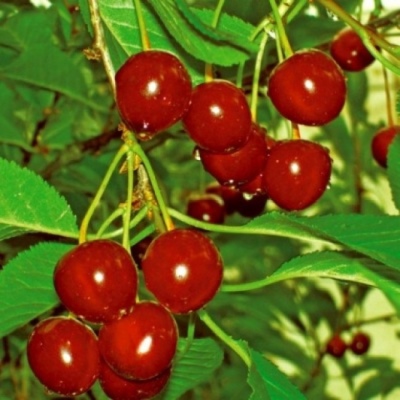
- Fruit shape: rounded heart-shaped
- Authors: O.S. Zhukov, G.G. Nikiforov (I.V. Michurin VIIIGiSPR)
- Year of approval: 2010
- Growth type: medium-sized
- Appointment: universal
- Yield: high
- Crown: pyramidal
- Escapes: medium thickness, straight, brown-red
- Sheet: medium-sized, finely serrated edge, green
- Fruit size: large
Cherry variety Rodina was approved for use in 2010. The purpose of such cherries is universal. The variety is distinguished by its high yield, resistance to diseases and pests.
Description of the variety
Sweet cherry Rodina is a medium layer. Her crown is pyramidal. Shoots on plants of medium thickness, straight, brownish-red in color.
Medium-sized leaf plates. Their color is green. The flowers are white, rather large. The petiole is short. Homeland is a self-fertile variety, so it will need pollinators. Young buds grow large on trees. Their shape is ovoid.
Fruit characteristics
Ripe fruits are rather large in size. Their average weight is 4.5-5 grams. Their shape is heart-shaped, rounded. The color is dark burgundy, closer to black. A slight glossy shine can be seen on the surface.
The skin on ripe berries is dense. The flesh is cartilaginous, its color is light red. Dark juice. The seed in the berries is large. The fruits are highly transportable. In addition, the berries have good keeping quality after picking.
Taste qualities
Ripe cherries of this variety have a sweet and sour taste. The tasting score was 4.5 points. The purpose of the berries is universal. They can be consumed raw. They are also suitable for making jams, juices, preserves and other sweet dishes.
Ripening and fruiting
Sweet cherry Rodina begins to bear fruit 4-5 years after planting in a permanent place. Ripening dates are early.

Yield
The Rodina variety has a high yield level. From 1 hectare of planting it will be possible to collect an average of 107.6 centners of berries. The yield of this species is stable.
Growing and caring
The most suitable region for growing such a crop is considered to be Central Black Earth. This type of sweet cherry needs well-ionized soils with oxygen, so loosening should be carried out before planting. And also regularly you will need to repeat this procedure during the growth of trees. When planted in heavy soils, the crop will not receive enough nutrients.
The homeland does not tolerate waterlogging well, therefore, young seedlings should not be planted in places where underground waters pass. This cherry prefers fertile light or sandy loam soils. Beforehand, you need to add some organic fertilizers there.
Remember that seedlings will need to be planted adjacent to other cherry varieties for cross-pollination to occur. Otherwise, the trees will not bear fruit.
Sweet cherry Rodina is considered unpretentious to the water content in the soil (4-5 waterings per season will be enough). But remember that excessive moisture can lead to the death of vegetation.
Despite the fact that the variety is frost-hardy, trees will need to be covered before the onset of frost.Like many other varieties, this cherry will need periodic pruning and top dressing.




Disease and pest resistance
Sweet cherry Rodina has good resistance to coccomycosis, which affects shoots and leaf blades. But at the same time, she often suffers from perforated spotting, moniliosis.
Sick trees are treated with copper oxychloride, Bordeaux liquid, and copper sulfate. And also the chemical preparation "Horus" will do.
Sweet cherry Rodina sometimes suffers from the invasion of various pests, including aphids, cherry flies, moths and leafworms. These parasites actively feed on plant juices. And they are also carriers of a variety of diseases.
To destroy these harmful insects, you can use drugs such as Actellik, Nitrafen, Confidor. If the lesion is insignificant, then you can process cherries with folk remedies (tinctures with tobacco dust, with wood ash).


Review overview
Many gardeners spoke positively about the cherry of this variety. Separately, it was said that ripe fruits have good taste. They are all quite dense. It will be possible to get a stable high-grade crop annually.
Gardeners noted that this variety easily tolerates temperature extremes. In winter, they will not freeze. According to gardeners, this species can be perfect not only for consumption in its raw form, but also for preparing various preparations for the winter.































































